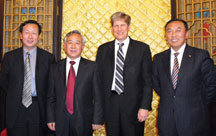Using Artificial Intelligence (AI) on ASTM standards and related intellectual property is prohibited. Violations will result in suspension of access.

Jul 26, 2016
On April 17–23, ASTM International President James Thomas visited China to meet with officials, technical experts, academics and ASTM members regarding standards development and application, certification and cooperation. The visit enhanced the existing cooperation between ASTM and its partners and provided the chance to explore new opportunities.
While in Beijing, Thomas had discussions with representatives of the following organizations.
In addition to the above-mentioned bilateral communications, Thomas hosted a reception and dinner for his old and new colleagues in China, including standards officials and experts represented by Shi Baoquan, vice administrator, Standardization Administration of the People's Republic of China (SAC), and technical officials and experts represented by Lu Yansun, the former vice minister of the Machinery Industry.
ASTM members from the fields of machinery, environment, petroleum, building materials, sports, textiles and consumer products were among the guests at the event, reflecting the broad range of applicability and interest in ASTM International standards in China and providing another indication of the cooperation between ASTM and Chinese standards activities in various sectors.
On April 16, ASTM International and the China National Institute of Standardization jointly held a workshop on ASTM Metals Standards and Application in Beijing, China. More than 50 Chinese experts from the metal sector attended the event.
Focusing on ASTM nonferrous metal standards and application, two ASTM Board members Paul Whitcraft, Rolled Alloys, and Carroll Davis, ALCOA, gave the presentations on ASTM standards for nonferrous metals, particularly nickel alloys and aluminum; Passport to Steel, a premier ASTM International publication that provides a database of steel standards from 11 standards development organizations; and how standards enable business to conduct quality control, perform engineering assessments and gain access to global markets.
Davis' and Whitcraft's presentations were followed by question and answer discussions covering standards for steel, nickel and aluminum; steel specifications and grading differences in the United States and China; standards applicability; ASTM's proficiency testing programs, and other subjects.
Liu Fei, ASTM's chief representative in China, also joined the CNIS staff panel discussing ASTM membership (process and benefits), voting balance, negative ballot handling, review requirements for standards, standards and market access, the cost of standards and copyright, and ASTM's compliance with the international standards principles of World Trade Organization Agreement on Technical Barriers to Trade. Participants engaged in the discussions, and this approach made the program beneficial for all, particularly in regard to understanding the extensive utilization of ASTM standards in China.
July / August 2010
028